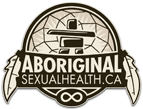Aboriginal Women's Health
Mothers. Grandmothers. Daughters. Sisters. Strong, healthy women are the foundation of thriving, connected communities. Yet, everyday Aboriginal women face sexual and reproductive illnesses that can be prevented. Aboriginal mothers and their children experience poor health outcomes that can be eliminated.
At the SOGC, improving Aboriginal women's health is a priority. As women's health professionals we recognize that the need to improve access to culturally-safe health services is a key and underlying priority.
Sexual and Reproductive Health
My First Contraception and STI exam
Did you know? Over 75% of Canadians will get one STI in their lifetime. 85% of women who have sex without a method of birth control will get pregnant within one year. Starting to think about your sexuality? It's time to talk about birth control, STI's and safer sex. Know your options. Watch this short video with the SOGC's Dr. Black in English, Cree, Ojibwa and Inuktitut to learn about contraception and STIs.
My First Pelvic Exam
Routine Pap testing is recommended for all Canadian women who are sexually active, or age 21 and older. But it's your body and you've got questions. What is a Pap test? Will it hurt? Can someone come with me?
Got questions about your first pelvic exam? You're not alone. Be informed. Watch this short video with the SOGC's Dr. Black in English, Cree, Ojibwa and Inuktitut to learn all about your first pelvic exam.
Contraception Flip Chart

85% of unintended pregnancies occur when no contraception is used. If you're sexually active, but not ready to have a baby, you have options - from the Pill, to condoms, to diaphragms, and much more.
The SOGC's sexualityandu.ca contraception comparison chart lets you compare birth control methods side-by-side, helping you choose the contraceptive that's right for you. Learn more about the options available in Canada by comparing their benefits, disadvantages, how they work, and how effective they are at preventing pregnancy.
Most contraceptives require a prescription and several are covered by NIHB.
To choose a contraceptive that's right for you, click here. ( PDF 8.13MB)
All About STIs
Sexually Transmitted Diseases (STI's). What are they? Who gets them? How can I avoid them?
Prevention, symptoms and treatment. There is a lot of information out there about STI's. If you're looking for answers straight from one of the SOGC's STI experts watch this 10 minute video. Learn about bacterial, parasitic and viral STIs. Get tested and learn how to protect yourself.
Choose safer sex. Click here for a crash course on STI's with Dr. Black in English, Cree, Ojibwa and Inuktitut.
HPV facts for Aboriginal youth

Respect yourself, your partner, and your community. The human papilloma virus (HPV) is considered to be the most common STI in Canada. Most infections occur in young people, aged 15-24. Often there are no visible signs or symptoms.
In consultation with the Youth Council of the Assembly of First Nations (AFN) and the Native Youth Sexual Health Network (NYSHN), the SOGC has created a pamphlet that offers key HPV facts for Aboriginal youth.
Learn how to keep the Nation healthy.
Visit, hpvinfo.ca
Adam Beach, Sexuality and You
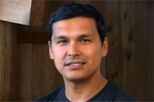
In this exciting video series produced with the SOGC's award winning website sexualityandu.ca, Adam Beach, an Aboriginal actor from Dog Creek First Nations Reserve in Lake Manitoba talks to Aboriginal youth about healthy and safe sexual relationships, contraception, STIs, sex education and much more.
To see what he has to say
“I am me” Video
Produced by the Eskasoni First Nation Health Centre, this video features youth from the Eskasoni high school talking about being sexually active and the importance of getting a pap test - a test that checks for infections, unhealthy cervical cells or cervical cancer.
To see what they have to say, click here.
Joint Policy Statement: Sexual and Reproductive Health Rights, Realities and Access to Services for Aboriginal People in Canada
In 2010, the SOGC teamed with the Assembly of First Nations (AFN), the Native Youth Sexual Health Network (NYSHN), Pauktuutit Inuit Women of Canada, and the Canadian Federation of Sexual Health (CFSH) to create a joint policy statement, affirming the sexual and reproductive health (SRH) rights of First Nations, Inuit and Métis (FNIM) women and youth.
Through this Statement, we aim to foster awareness about FNIM SRH rights and realities among health professionals, organizations and stakeholders across Canada, many of whom work with Aboriginal women and youth. We aim to support the delivery of culturally-safe care. This document also provides a common starting point, helping us move forward in the development of accessible, culturally-relevant public health materials and youth-driven, community-based projects to support improved SRH.
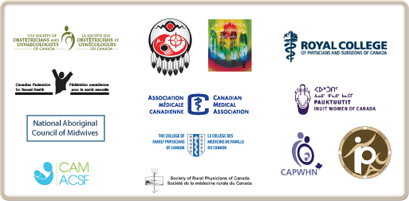
Endorsed by:
Sexual Health Toolkit: First Nation's Center, NAHO
Created in collaboration with the Native Youth Sexual Health Network (NYSHN) and reviewed by the Aboriginal Health Initiative Committee of the SOGC, the First Nation's Center of the National Aboriginal Health Organization (NAHO) has produced a new toolkit on sexual health. Packed with information and resources on STIs, contraception, NIHB coverage, sexual violence, body image and traditional views on sexual health, this toolkit is now available online.
For Part One - Sexual Health, STIs and HIV/AIDS, click here.
For Part Two - Healthy Relationships, Abuse and Body Image, click here.
Sexual Health in the Canadian North
Do you live in the Yukon, North West Territories or Nunavut? Want to know more about sex, STIs, health and healthy sexual relationships? Visit the Northern Sexual Health Portal and access the sexual health websites of the Canadian territories. Or, check out the sites from each of Canada's northern territories by clicking the links below.
Cervical Cancer and Screening: NAHO Factsheet
In Canada, Aboriginal women are more likely that non-Aboriginal to get cervical cancer. It accounts for approximately 15% of all cancers in Inuit women, with most cases diagnosed among women between 20-39 years of age. Get the facts. With early detection, cervical cancer can be successfully treated.
Inuit and Cancer: A Fact sheet by Inuit Tapirit Kanatami (ITK)
Breast, colorectal, trachea, bronchus, and lung cancer. These are the most common forms of cancer among female Inuit in the North West Territories. Yet, cancer screening and early detection programs available to Inuit are limited and often Inuit women are not diagnosed until the cancer is at an advanced stage.
Learn more about Inuit's unique cancer concerns and realities.
Finding our Way: A Sexual and Reproductive Health Sourcebook for Aboriginal Communities
In 2002, the Aboriginal Nurses Association of Canada and Planned Parenthood Federation of Canada, published this Sourcebook, launching a new resource for both Aboriginal and non-Aboriginal service providers - nurses, community health representatives, teachers, counsellors and other community workers - who work with First Nations, Inuit and Métis individuals and groups in Canada.
This Sourcebook offers information about sexual and reproductive health within an Aboriginal cultural context. It looks at traditional teachings and the history of Aboriginal peoples and also provides information on specific topics such as sexuality, education for children and youth, healthy pregnancies, teen pregnancies, menopause and sexual abuse. It includes suggestions for working with Aboriginal clients in different settings, some activities and handouts, sources of other useful materials, and where to look for more information.
Healthy Sexuality and Fighting Homophobia: Native Youth Photography Project
With support from the Public Health Agency of Canada, the Native Youth Sexual Health Network brought together First Nations youth from across Canada in March 2010 to create a national campaign about sexuality and fighting homophobia. These are the images created from the campaign which can be utilized as posters, postcards, as well as community newspaper inserts for articles and awareness.
Assembly of First Nations National Youth Council - Sexual Health Video Series
In March 2010, with funding help from the Public Health Agency of Canada, the Assembly of First Nations (AFN) National Youth Council (NYC) produced their own video series on sexual health, based on personal stories, issues and a traditional understanding of sexuality and its relationship to the sacredness of life. These five videos tell their stories and views of sexual health, and much more.
AFN NYC - Video series on sexual health
Aboriginal Maternal and Child Health
Healthy Beginnings - 4th edition
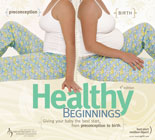
Healthy Beginnings: Giving your baby the best start, from preconception to birth is the ultimate step-by-step guide to pregnancy and childbirth. From preconception to postnatal care, Healthy Beginnings is a premier resource for mothers-to-be, mothers and caregivers alike, creating an accessible guide with the most up-to-date expert maternal information.
Visit the SOGC website and get your copy today!
Healthy Beginnings, Supportive Communities: A Strong Future

In 2009, the Métis Center of the National Aboriginal Health Organization (NAHO) met with Métis in different parts of Canada to share and collect stories, teachings and information about maternal-child well-being. This DVD is the result of all the things we learned from Métis midwives, health professionals, Elders and parents.
To order your copy, contact NAHO's Métis Center at metiscentre@naho.ca, or click the icon below.
Born on the Land with Helping Hands
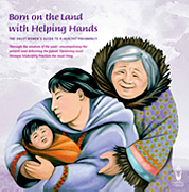
The Inuit women's guide to a healthy pregnancy! Through the wisdom of the past - encompassing the present and delivering the future. Preserving Inuit Women Midwifery Practices the Inuit Way.
With funding from the First Nations and Inuit Health Branch (FNIHB) of Health Canada, Pauktuutit Inuit Women of Canada produced this special pregnancy calendar for Inuit women. Featuring key medical information and your baby's developmental milestones, this calendar contains important and helpful information that Inuit midwives have known for thousands of years.
To view a PDF version of the Pregnancy Calendar, choose from the following: English; Inuktitut; Inuinakton; Nunavik; Nunatsiavut
Midwifery and Aboriginal Midwifery in Canada Map
Produce in 2008 by the First Nation's Center of NAHO, this map identifies midwifery practices, organizations and education programs by Province and Territory. The map also identifies midwifery practices with Aboriginal midwives and First Nation reserve locations.
To view the map, click here.
For more information on Inuit midwives and maternity care workers and those who work with them, visit the Irnisuksiiniq - Inuit Midwifery Network.
Returning Birth to Aboriginal, Rural, and Remote Communities
 With a severe shortage of human resources, Canada's maternity care environment is in crisis. This particularly affects access to quality maternity care for women living in rural and remote areas. 21% of women in Canada - many of them Aboriginal- live in rural or remote communities. When it comes time to give birth, women are required to leave their communities. With routine birthing evacuations, Aboriginal women are forced to experience birth alone, far from their homes and communities. For many healthy pregnant women, this has resulted in stressful, lonely and costly births, with negative health outcomes.
With a severe shortage of human resources, Canada's maternity care environment is in crisis. This particularly affects access to quality maternity care for women living in rural and remote areas. 21% of women in Canada - many of them Aboriginal- live in rural or remote communities. When it comes time to give birth, women are required to leave their communities. With routine birthing evacuations, Aboriginal women are forced to experience birth alone, far from their homes and communities. For many healthy pregnant women, this has resulted in stressful, lonely and costly births, with negative health outcomes.
The SOGC strongly supports returning birth to Aboriginal, rural, and remote communities for low-risk pregnancies. We aim to collaboratively forge a federal-provincial-territorial strategy that enables the delivery of high quality, culturally-safe obstetrical and midwifery services for low-risk Aboriginal women who choose to remain in their communities to give birth.
click here to view our policy statement on Returning Birth.
Adopted by SOGC Council and published in the JOGC!
Best Practices for Returning Birth to Rural and Remote Aboriginal Communities
During the last four decades, policies and practices based on modern obstetrical techniques and knowledge have replaced traditional practices in many rural and remote Aboriginal communities. As most of these communities do not have obstetrical facilities or staff, women have to leave their communities to give birth. Looking at best practices concerning the care of pregnant women, this paper explores the extent to which returning birth to rural and remote communities is practical and safe.
Reviewed by the Aboriginal Women's Health Committee approved by the Executive and Council of the SOGC and published in the JOGC!
Teenage Pregnancy
Over 50% of Aboriginal women become mothers before their 25th birthday.
Early parenthood can be a choice. But teen pregnancies also reflect limited access to relevant information, contraception and other health resources. Sexual violence and abuse also play a role. In addition to important social and economic considerations of early parenthood, pregnant teens face increased risk of health problems.
To learn more, check out some of the resources below:
In June 2010, the Cherokee Youth Council (CYC) produced this video on teen pregnancy prevention, reaching out to native and non-native youth.
Unintended Pregnancy
In Canada, abortion is considered a safe, legal, insured and funded service. This means that a woman should not have to pay for abortion services in Canada. However, access varies from one province or territory to the next and many women experience significant barriers to quality, timely and affordable services. This is particularly true for First Nations, Inuit and Métis women, especially if they are living in rural and remote areas.
The National Abortion Federation has made key information available on their website, including the availability of abortion services by province and territory, whether or not patients will have to pay on their own, and up to how many weeks terminations are performed. The NAF also maintains a free, anonymous hotline to answer any questions you may have. To learn more, visit www.prochoice.org
Canadians for Choice also maintains an information and referral line, linking women and men to counseling services, adoption services or support centers for women who decide to carry an unintended pregnancy to term. Working with the Native Youth Sexual Health Network, Canadians for Choice hosts a First Nations, Inuit, and Métis Committee, recognizing the historic effects of power and privilege that have marginalized the First Nations, Inuit, and Métis people from asserting their full and rightful positions in the areas of reproductive and sexual health.
Not Just About Women
Across the country, there are efforts to promote Aboriginal maternal and child health, advocate for women's sexual and reproductive rights and end violence against women. This work aims to advance women's health and well-being, restore their status, and promote their rights. But what about the men in their lives?
The role that men play in women's lives towards health and well-being is often overlooked within women's health initiatives. Yet, in every society, community and household, men have the opportunity to play a positive role in women's health. This is also true in First Nations, Inuit and Métis communities.
To learn more about engaging men and boys in the promotion of Aboriginal women - and men's - health, look at some of the resources below.
Protecting the Circle: Aboriginal Men Ending Violence Against Women
In January 2010, the Native Youth Sexual Health Network (NYSHN) teamed up with Ryerson University in Toronto to present: "Protecting the Circle: Aboriginal Men Ending Violence Against Women".
Click here to download, read, share, and print this inspiring collection of written works by Aboriginal men from across Canada.
Finding our Way: A Sexual and Reproductive Health Sourcebook for Aboriginal Communities
Colonization. Racism. Additions. Violence. Too many men and boys live with a poor ability to have healthy relationships, to protect their sexual health from HIV/AIDS and other sexually transmitted infections, and to be free from sexual and physical violence. Métis, Inuit and First Nations men are beginning to examine how their roles in society have changed and to look at their own sexual health.
In 2002, the Aboriginal Nurses Association of Canada and Planned Parenthood Federation of Canada, published this Sourcebook, launching a new resource for both Aboriginal and non-Aboriginal service providers - nurses, community health representatives, teachers, counsellors and other community workers - who work with First Nations, Inuit and Métis individuals and groups in Canada.
For information dealing specifically with First Nations, Inuit and Métis men, click here.
“How are we as Men?” - Angutiilli qanuiliqpat?
In 2009, Inuit Tuttarvingat of NAHO produced a 4-part television series discussing the issues Inuit men face in today's society. In this series, listeners will hear a lively discussion between the panel - made up of people who work in the area of health and wellness - a studio audience, and viewers. Up for discussion? Men's roles in contemporary society, education, employment, tradition and culture, and much more, including programs and activities that are trying to improve the situation for Inuit men and their families.
Visit Inuit Tuttarvingat to view the series.
